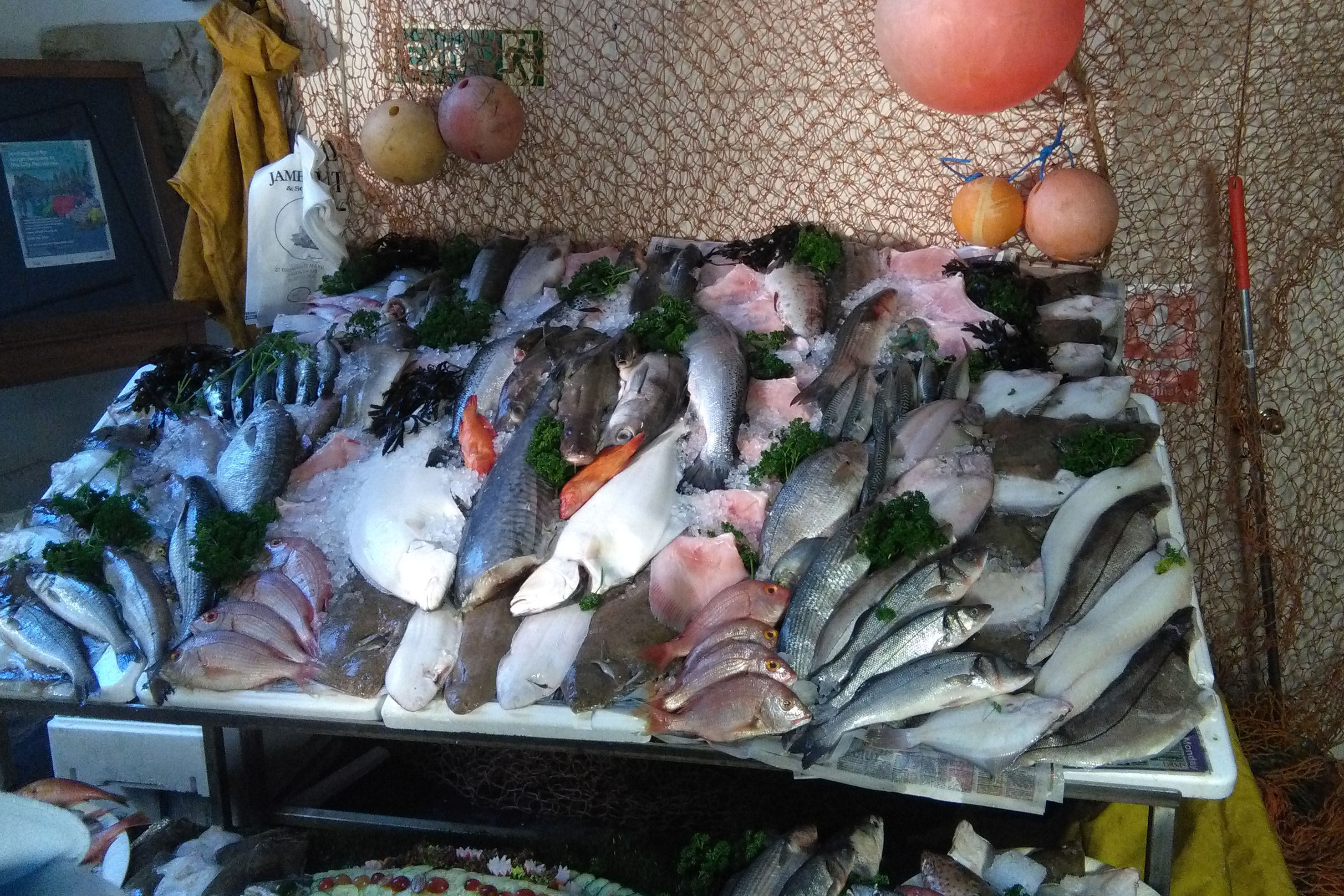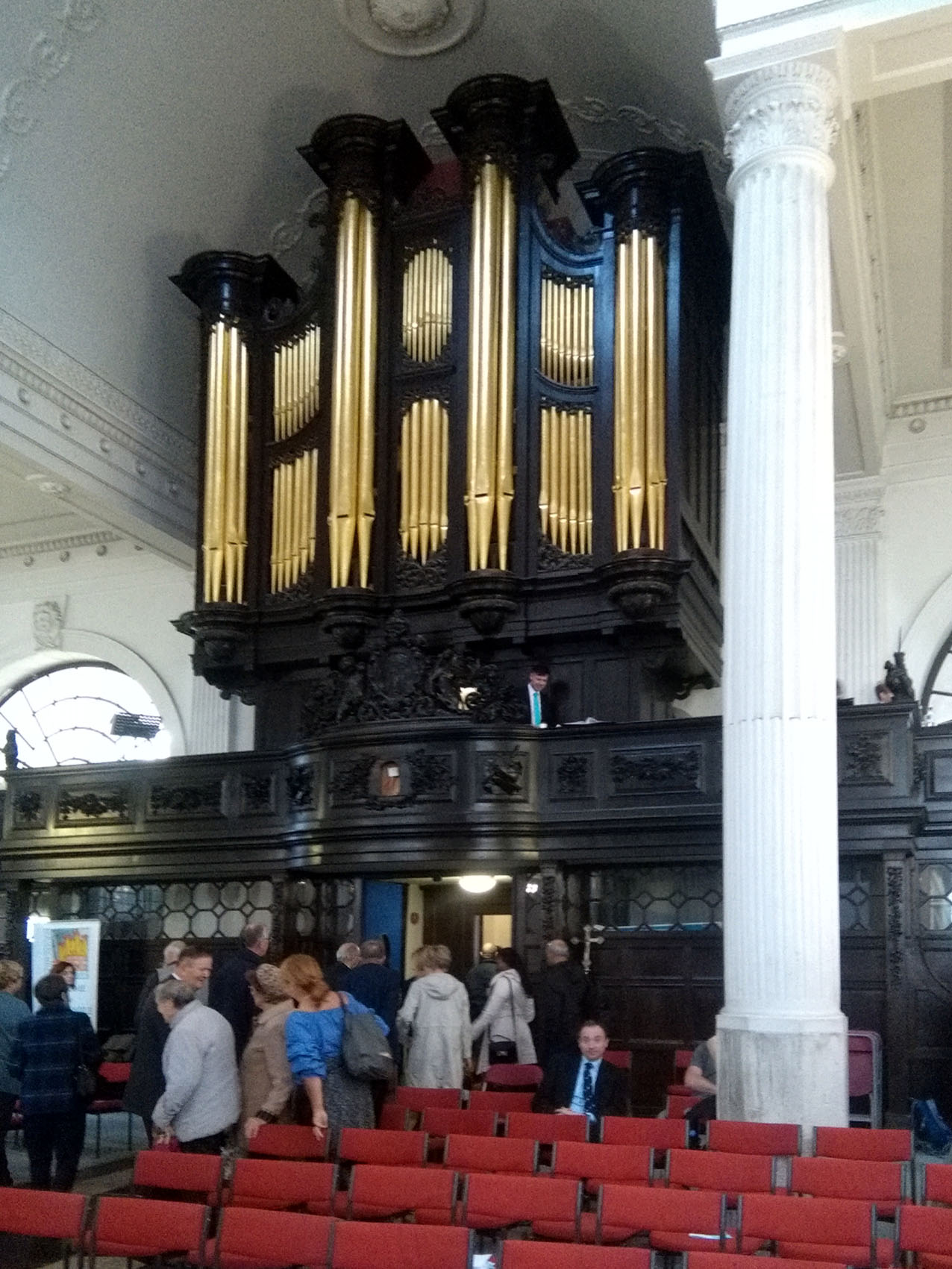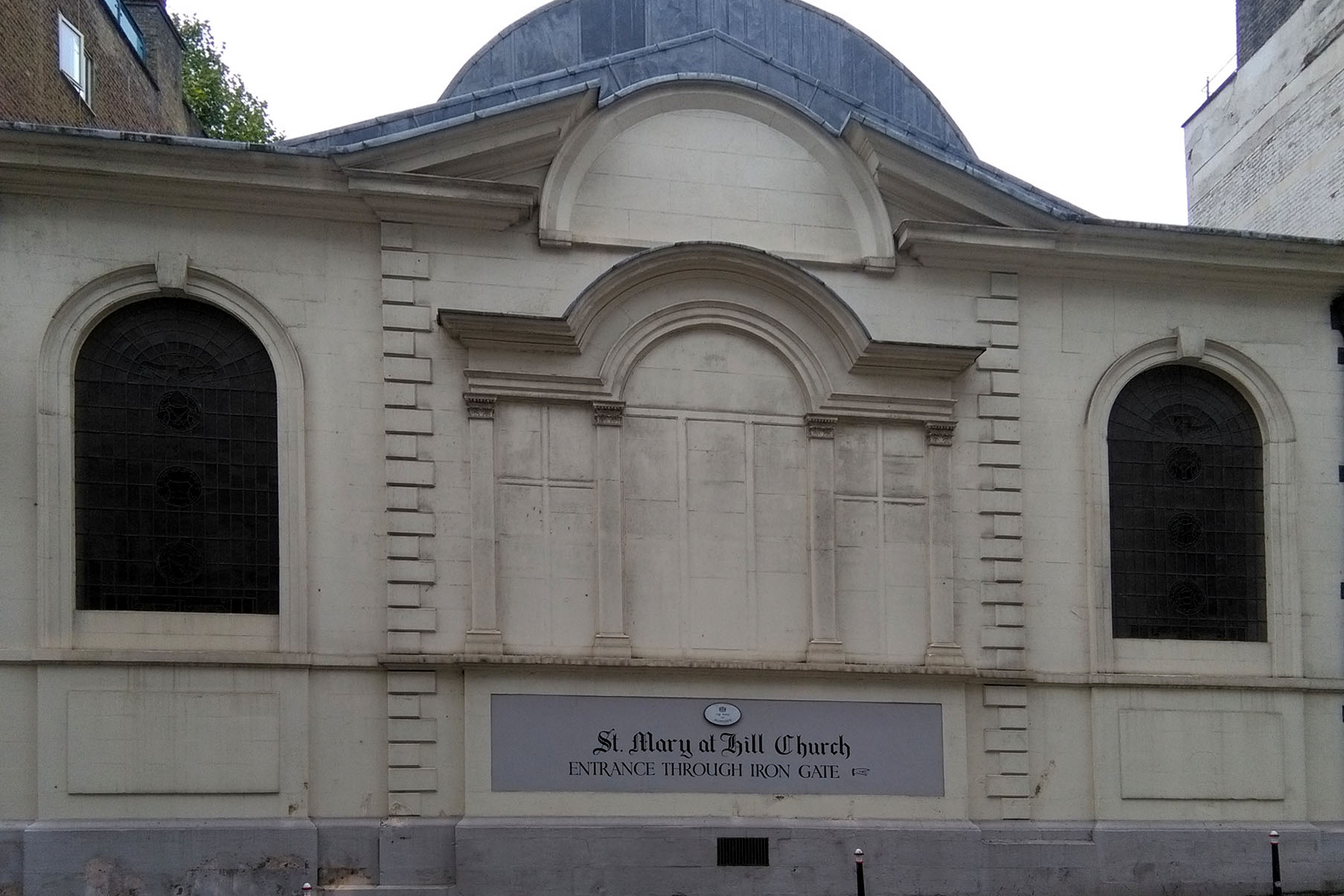|
Mystery Worshipper: Sipech.
The church: St Mary-at-Hill, Eastcheap, London.
Denomination: Church of England, Diocese of London.
The building: As with many churches in the Square Mile (which is what locals call the City of London historic centre and central business district), it is a Wren church, substantially rebuilt after the devastation of the Great Fire of London. Though it has undergone various alterations since, unusually it remained intact during the Blitz. One needs to come up a couple of steps to get into the church and I didnít spot a wheelchair ramp. When the church was hit by a fire in 1988, the box pews, though they survived, were put into storage and so the church has a very open, near cavernous feel to it. The eye is naturally drawn upwards to the inside of a dome on top of the church that is impossible to see from street level. Several posters commemorating the Reformation had been put up at various spots; I assumed these came from the Lutheran congregation who regularly use the building on Sundays (see below).
The church: For nearly a thousand years on this site, there has been a church linked to Billingsgate market, which was a few yards down the road. Although the market has since moved four miles to the east, the church has kept the association and as such holds an annual harvest festival with a slight difference – that being that it celebrates the harvest of the sea rather than of the soil. Here there is a display of fish put on by the fishmongers of Billingsgate market. The famed composer Thomas Tallis was the church organist for a short while in the 1530s. It is said that the church also used have a tradition called the Beating of the Bounds, where children and notable people of the parish would parade around the boundaries, receiving a mild beating at various points along the route; the tradition lives on at nearby All Hallows-by-the-Tower. At the turn of the 20th century, the church was under the ministry of Wilson Carlile, the founder of the Church Army, who would lead a band around the streets, playing his trombone, in an effort to bring people into the next church service. These days, as with many churches in the Square Mile, it has given up regular Sunday services, with St Anne's Lutheran Church using the building most Sunday mornings. The community of St Mary-at-Hill meet for communion at lunchtime on Mondays and early morning on Tuesdays. Once a month they also have choral evensong followed by a discussion, usually with a famous speaker.
The neighbourhood: The church is located down a tiny alley on the north side of the Thames about half way between London Bridge and Tower Bridge. It is just a few yards from Pudding Lane, which is where the Great Fire of London started. From the alley, though, one can glimpse the more modern side of London, as one can get a good view of the Shard, a "vertical community" incorporating retail, offices, hotel, apartments, restaurants and a public viewing gallery, to the south; and to the north, the office building known colloquially as the Walkie-Talkie building due to its shape.
The cast: The service was led by the priest-in-charge, the Revd Prebendary Rose Hudson-Wilkin, who also currently fills the role of Chaplain to the Speaker of House of Commons. The readings were given by Mavis Hughston, master of the Billingsgate Ward Club, and Robert Mingay-Smith, the director of music.
The date & time: Sunday, 8 October 2017, 11.00am.
Comment:
We have received a comment on this report.
What was the name of the service?
Fish Harvest Festival Service. It was also billed as "Choral mattins with wet fish display."
How full was the building?
It was very full, with a little over 150 present, most of whom appeared to be over the age of 50.
Did anyone welcome you personally?
On the door, the priest-in-charge said hello as I entered. An usher then invited me to take a look at the display of fish that was in a small room to one side, just inside the entrance. After I took my seat, no one said hello. I got the impression that pretty much everyone was a visitor and that they had come in small groups, talking among themselves but not among groups.
Was your pew comfortable?
We had individual chairs that had a modest amount of padding to them. They were more comfortable than they looked.
How would you describe the pre-service
atmosphere?
It was really rather loud. The organ was playing a volume that made conversation hard, though some people tried. It left with me quite a headache.
What were the exact opening words of the
service?
It wasn't possible to catch them, as the priest-in-charge stood at the back of church giving a blessing over the fish, but her microphone kept cutting out. So all we caught was: "Creator spirit ... [several sentences missed] ... bless this fish." Pity it wasn't a communion service, else she could have blessed some loaves as well.

What books did the congregation use during the
service?
We had a notice sheet that had been placed on the chairs. It contained the words to the hymns and the order of service. It was held together with a single staple, though mine was a bit ragged and I ended up cutting my finger on it.
What musical instruments were played?
An organ and, for some songs, a flute. According to the order of service, the organ is one of the ten most important organs in the history of British organ building. It is the largest surviving example of the early work of William Hill, dating back to 1848. It was silenced following the fire of 1988 but was restored in 2002.
Did anything distract you?
People sometimes refer to "church smell." Depending on your background, this might be the smell of dusty hymn books or it might be incense. But with the fish on open display, there was a noticeable odour of the sea wafting through. Thankfully, the fish was all very fresh, so it wasn't particularly unpleasant. Just unusual for a church setting.
Was the worship stiff-upper-lip, happy clappy, or
what?
It was a slightly unconventional service, but was largely within the choral tradition of the Anglican Church. The sung worship was led by an eight member choir, who were extremely capable, though there were only a few hymns that we were all able to join in with. The choral pieces were all on a maritime theme, and special prayers were said for seafarers and fishmongers. The service concluded with a singing of the national anthem.
Exactly how long was the sermon?
11 minutes.
On a scale of 1-10, how good was the preacher?
9 – The priest-in-charge is an accomplished public speaker. She was clear and humane, but she hinted at great, thought-provoking insights. For example, there was an anecdote about a fisherman and a businessman; the fisherman was happy with catching enough fish to feed his family, while the businessman tried to show him how he could catch more fish and make lots of money. But the fisherman held fast, a model of contentment.
In a nutshell, what was the sermon
about?
If God said that creation was good, why do we constantly hear stories that tell us the opposite? Stories of war, suffering and misery show us that somewhere along the line we have screwed up. What is it that drives us? Is it money, or rather a passion for what we do? The fishmongers at Billingsgate market work with a passion. We should live as though we believe that God has given us life and we should remember to say thank you. (By way of conclusion, she segued into a joke about an atheist who was chased by a bear and prayed that it might at least be a Christian bear – whereupon the bear suddenly stopped, bowed its head, and said: "Lord, for what we are about to receive, may we be truly thankful.")
Which part of the service was like being in
heaven?
At the end of the service, the priest-in-charge noted that this was only an annual service and gave a rundown of the church's other regular services. What made it nice was that she also encouraged us to come back to attend a service of the Lutheran congregation who normally use the building on a Sunday morning. It was a nice touch of ecumenicalism.
And which part was like being in... er... the other place?
As noted above, the microphone failure at the start meant that the opening blessing was missed by most. I would add to this the volume of the organ, which left me reaching for some painkillers.

What happened when you hung around after the service looking lost?
Refreshments were served from a couple of tables over to one side. I took some and then wandered round the church, as did many others, But nobody spoke to me at all. The priest-in-charge was taking up a collection for a charity that provides accommodation and welfare for seafarers, ex service personnel and others in need of accommodation; she was using an upturned fishmonger's hat to receive the donations.
How would you describe the after-service
coffee?
There was no tea or coffee on offer. Instead, the liquid refreshment was wine, with a choice of white or red. The red wine was a bit grainy, taking some effort to drink. There was also a wide selection of nibbles, including mini tartlets, sushi and sandwiches.
How would you feel about making this church your regular (where 10 = ecstatic, 0 = terminal)?
7 – If I worked in the area I'd definitely aim to visit the midweek services. But I recognise that this was a special service, perhaps not representative of the day-to-day life of the church.

Did the service make you feel glad to be a
Christian?
Yes.
What one thing will you remember about all this in seven days' time?
The nagging thought that if this is where the fish were, where were the loaves?
|


